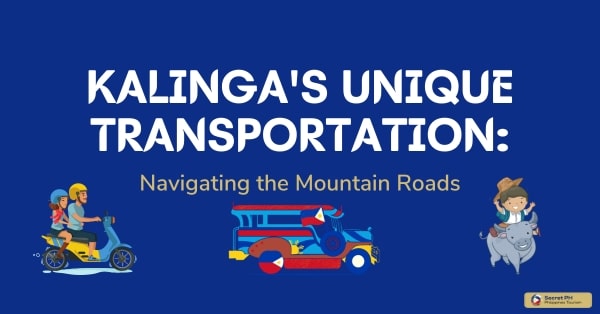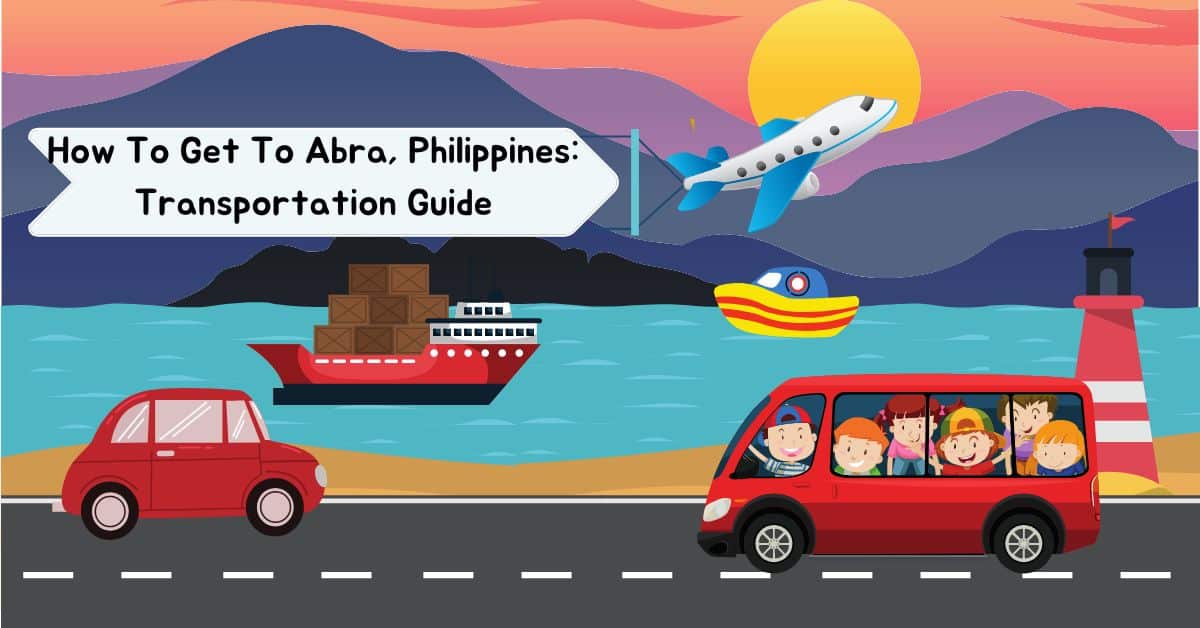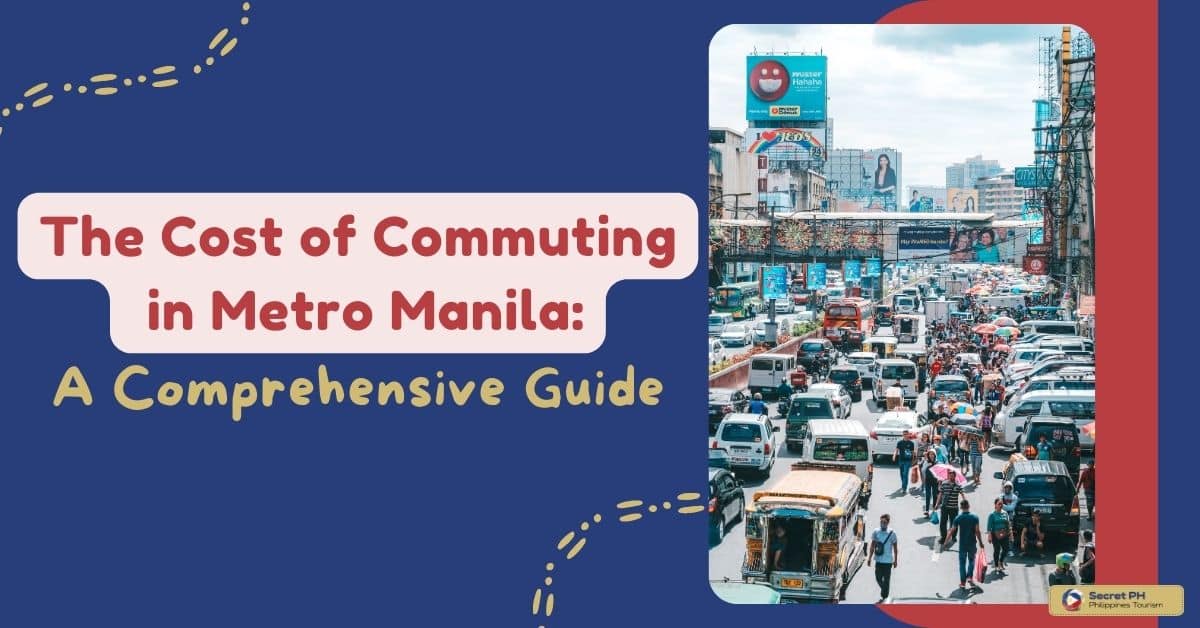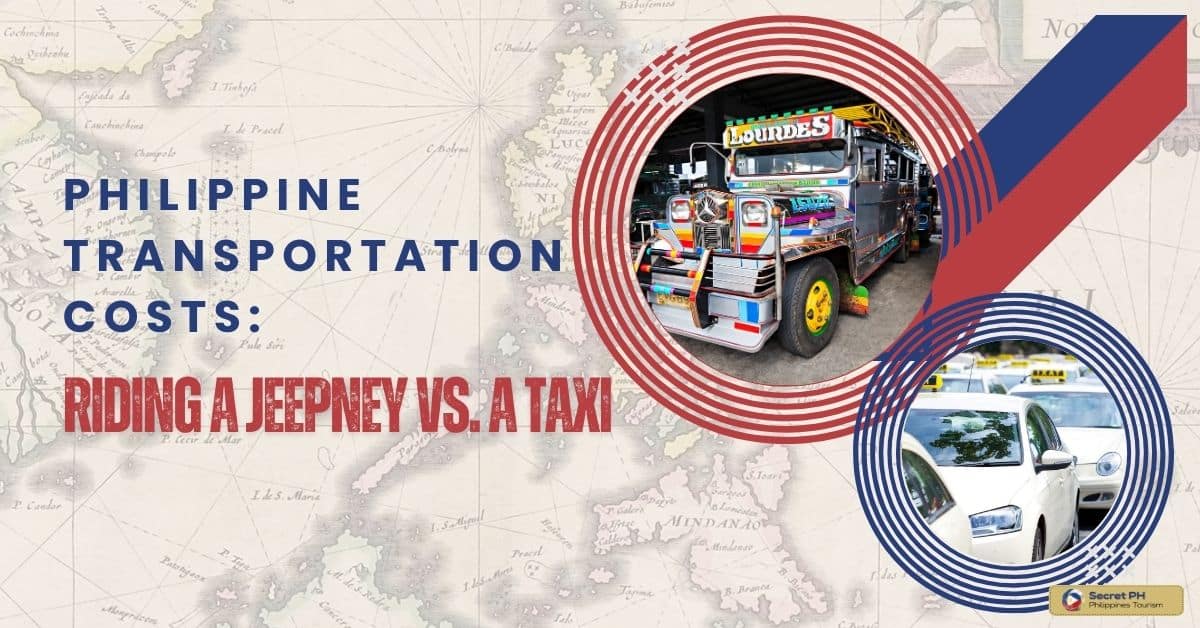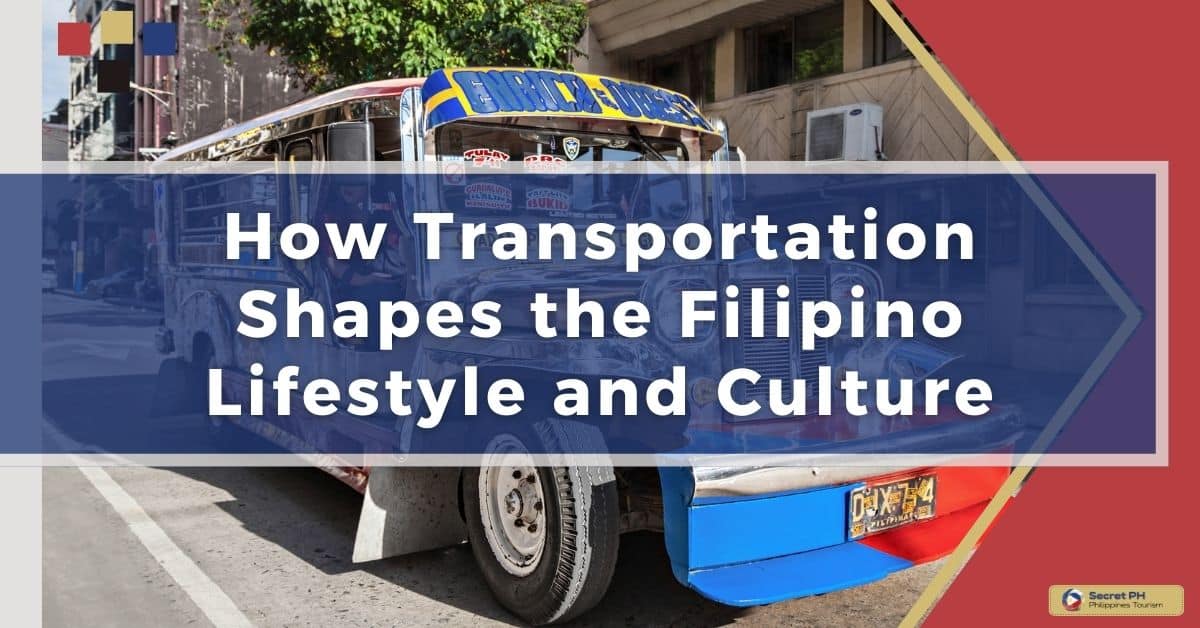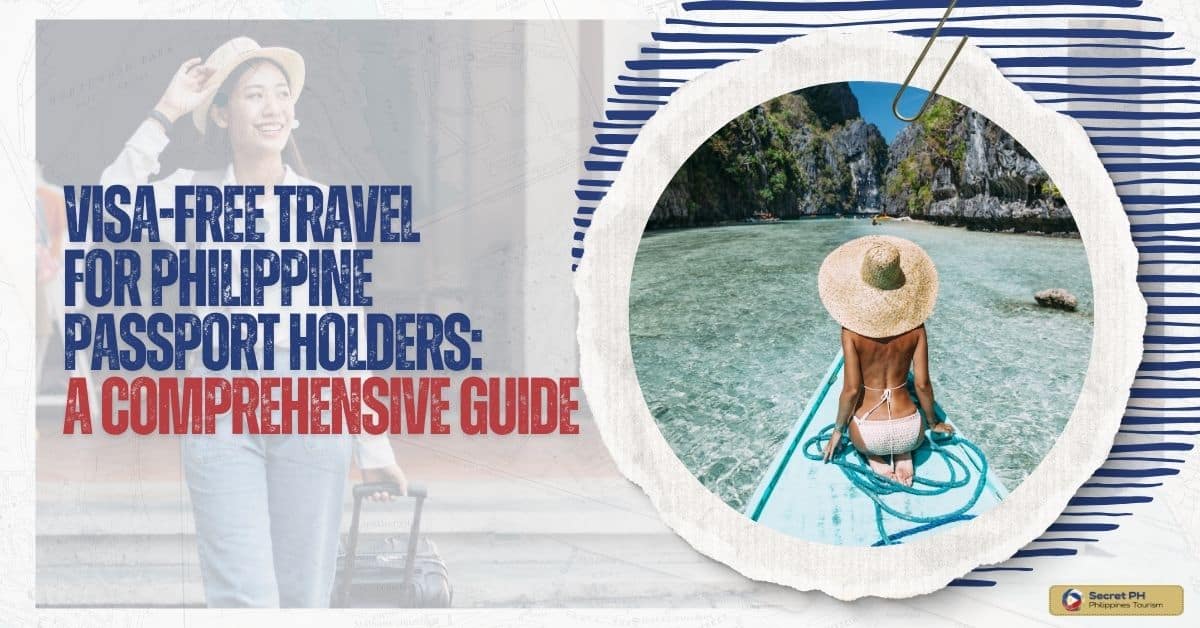Transportation in the Philippines can vary greatly between cities and countryside. In cities, jeepneys, taxis, tricycles and buses are popular, while tricycles, buses, multi-cabs, and habal-habal are popular in rural areas. Knowing the advantages and disadvantages of each mode and cost considerations can greatly improve your travel experience in the Philippines.
In this blog, we will be uncovering the nuances of both while delving into the challenges they pose. Whether you need a practical guide to getting around Philippines’ urban centers, or a deep dive analysis into intercity transportation logistics, this blog has it all.

Transportation in the Philippines
Transportation in the Philippines is a crucial part of daily life for most citizens. Public transportation, such as railroad and bus systems, is available throughout the country. However, some areas are more remote than others and have limited access to these services. Metered taxis are popular in urban areas where fares can be relatively affordable or shared with other passengers to reduce costs.
An increasingly popular ride-hailing services has made traveling even easier. In rural areas, jeepneys provide an economical form of transport that often travel between villages without fixed routes or schedules. Bicycles are also commonly used by locals to cover shorter distances. While ferry services operate between many islands, due to a network of domestic flights across the archipelago.
Navigating the Cities
Navigating the cities can be a daunting task, especially to the unfamiliar traveler. In order to find your way around effectively, it is important to get your hands on a reliable guidebook or map, and better yet, ask locals for directions. Once you know the main streets and neighborhoods, often times you can orient yourself before setting out on foot that day.
Pay attention to landmarks and street names, as these will help immensely with navigation if you ever feel lost. Make sure to keep track of your location throughout the day; small devices like smartphones make it easy to pull up a map no matter where you are.

Urban Transportation
With the amount of traffic, pollution, and congestion that are common in cities, it can be difficult to find reliable means of transportation. While traditional methods such as driving cars and taking public transport still remain popular, many cities have adapted to introduce new solutions.
Popular Modes of Transportation in Cities
In the Philippines, different popular modes of transportation have been utilized by city dwellers to get around. Walking, biking and motorcycling are common methods people opt for in areas where distances between points of interest are short.
Those who have farther destinations tend to prefer driving private vehicles or hailing taxis. On top of these modes, public transportation like buses and jeepneys have established its niche in cities as well.
Jeepneys
Jeepneys are perhaps the most iconic form of transit, as they are customized vehicles that were originally military jeeps. They are brightly colored and vary in size and style.
| ADVANTAGES | DISADVANTAGES |
| Affordable fare | Crowded and cramped |
| Widely available | Lack of comfort |
| Can navigate narrow or congested streets | No fixed routes or schedules, making it harder to plan trips |

Taxis
Taxis are a popular mode of transportation for navigating the cities in the Philippines. They provide a convenient and flexible option for traveling. They can be easily hailed on the street or called in advance.
Taxis in the Philippines are usually metered, with the fare determined by distance traveled and time spent in traffic. Many taxis now accept cashless payments for added convenience.
| ADVANTAGES | DISADVANTAGES |
| Convenient and flexible | Can be more expensive than other modes of transportation |
| Can be hailed on the street or called in advance | Some drivers may overcharge or take longer routes to increase the fare |
| Usually metered, with the fare determined by distance and time | Not as widely available in some areas |

Tricycles
Tricycles are a common mode of transportation in the cities of the Philippines, especially in areas where larger vehicles cannot easily navigate. They are three-wheeled motorized vehicles that can carry a limited number of passengers. Tricycles are usually more affordable than taxis, and the fare is usually negotiated with the driver in advance.
| ADVANTAGES | DISADVANTAGES |
| Affordable fare | Limited number of passengers |
| Can navigate narrow or congested streets | Can be cramped and uncomfortable |
| Can reach destinations that larger vehicles cannot | Lack of regulation in some areas can result in overcharging or subpar vehicles |

Buses
Buses are a popular mode of transportation in the cities of the Philippines. Offering a convenient and affordable way to get around. They come in various sizes, with some being large, air-conditioned coaches, others are smaller and less comfortable.
Buses are typically used for longer trips and can cover greater distances. They run along fixed routes and have designated stops, making them an efficient way to get around the city.
| ADVANTAGES | DISADVANTAGES |
| Convenient and affordable | Can be delayed due to heavy traffic |
| Run along fixed routes and have designated stops | Lack of designated bus lanes can make for a slow journey |
| Can cover greater distances than jeepneys or tricycles | Crowded and cramped, with limited comfort. |

Tips for Navigating the Cities
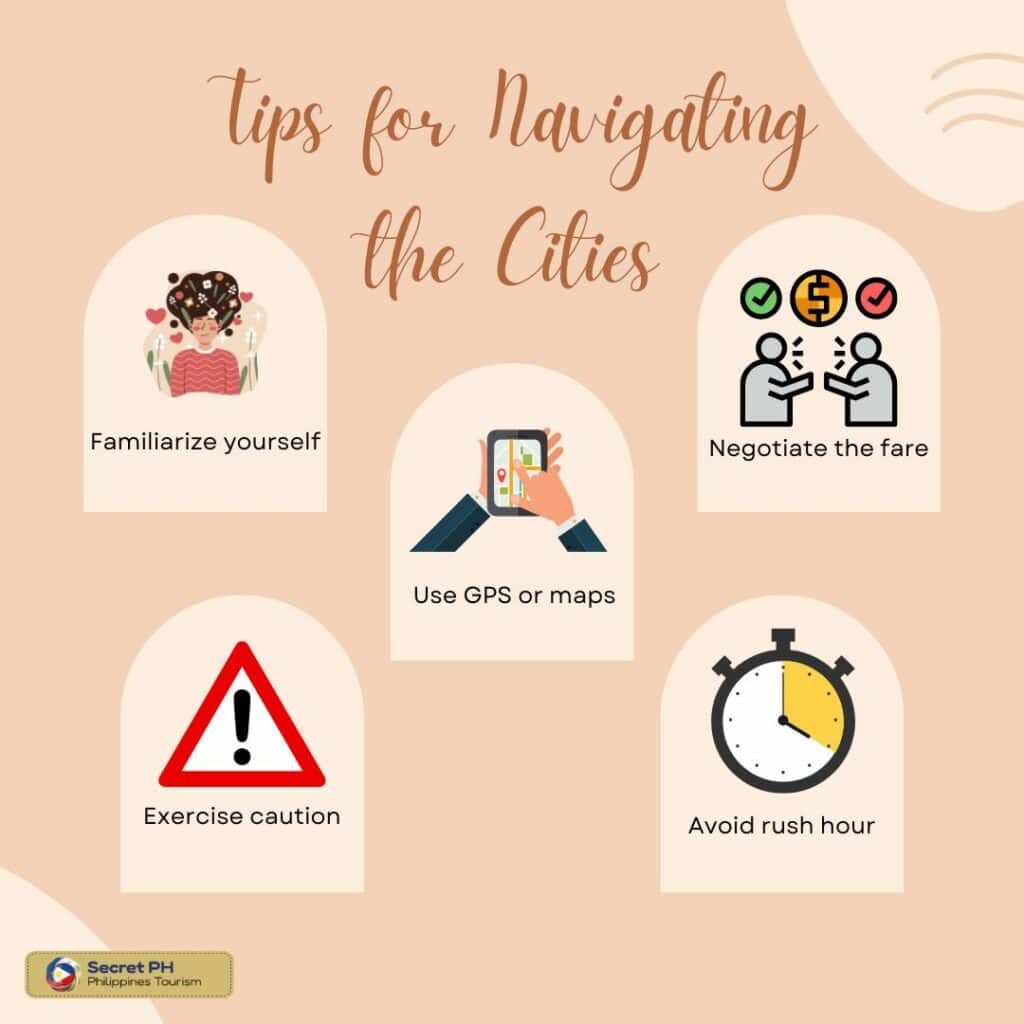
Familiarize yourself with the different modes of transportation
Knowing the pros and cons of each mode can help you choose the most efficient and cost-effective way to get around the city.
Negotiate the fare in advance
For tricycles and some taxis, the fare is negotiated in advance. Make sure to agree on the price before starting the journey to avoid overcharging.
Use GPS or maps
Having a GPS or a map can help you plan your route and estimate the time it takes to get to your destination. It can also help you avoid getting lost in an unfamiliar city.
Exercise caution
In some areas, drivers may take longer routes or overcharge passengers, especially tourists. Be mindful of the price and make sure to check the meter or negotiate the fare in advance.
Avoid rush hour
Rush hour can be a nightmare in the cities, with heavy traffic and long delays. Try to plan your trips during off-peak hours to avoid getting stuck in traffic.
Exploring the Countryside
Exploring the countryside of the Philippines is a truly rewarding experience. From towering mountain ranges to vast stretches of rolling hills and crystal-blue waters. Beaches are either free or cheap to enter, while host towns often provide basic amenities.
Visiting museums and culturally rich sites offers excellent opportunities to learn more about Philippines’ rich history, culture and customs. Whether you’re looking for adventure in an untamed wilderness or interested in experiencing unique Filipino traditions.

Rural Transportation
Exploring the Philippines countryside is an exciting adventure that will take you through stunning landscapes. Uncover hidden pathways and uncover local treasures like beautiful waterfalls that can be found deep in the jungle or quaint fishing villages.
You’ll feel a sense of reward when stumbling upon these wonderful places as they reward you with fresh, authentic experiences in Philippines rural areas. Whether it’s coastal hikes, camping escapes or cycling trails, there are countless opportunities to explore the Philippines countryside.
Popular Modes of Transportation in the Countryside
In the Philippines, people outside of metro cities rely on various and unique forms of transportation to move from place to place. Plenty of people living in the countryside have developed their own methods for traveling across the region. Here are some of them:
Tricycles
Tricycles are a common mode of transportation in the countryside of the Philippines. Particularly in remote or rural areas where larger vehicles cannot easily navigate. They are similar to the tricycles used in the cities. They often have modifications, such as sidecars, to accommodate more passengers or cargo. Tricycles in the countryside are often used for short trips, such as getting to and from a local market or school.
| ADVANTAGES | DISADVANTAGES |
| Convenient | Uncomfortable |
| Good for Short Distances | Not Safe for Luggage |
| Affordable | Limited Availability |

Buses
Buses are also a common mode of transportation in the countryside of the Philippines. Offering a convenient and affordable way to travel between rural communities and nearby cities. Buses in the countryside may be larger and more comfortable than those in the cities. They often run along established routes with designated stops.
The fare is usually determined by the distance traveled and is collected by the conductor. Buses can be a more efficient way to travel in the countryside compared to jeepneys or tricycles, as they can cover greater distances.
| ADVANTAGES | DISADVANTAGES |
| Comfortable | More Expensive |
| Reliable | Less Flexible |
| Large Luggage Capacity | Longer Travel Time |

Multi-cab
A multi-cab is a type of small, compact vehicle commonly used as a mode of transportation in the countryside. Multi-cabs are similar to jeepneys, but are smaller and more maneuverable. They are well-suited for navigating narrow and winding rural roads. They are often used for short trips within a local area, and may be operated as a shared taxi or private hire. The fare is usually negotiated with the driver in advance.
| ADVANTAGES | DISADVANTAGES |
| Affordability | Limited Seating |
| Versatility | Safety Concerns |
| Accessibility | Maintenance Issues |
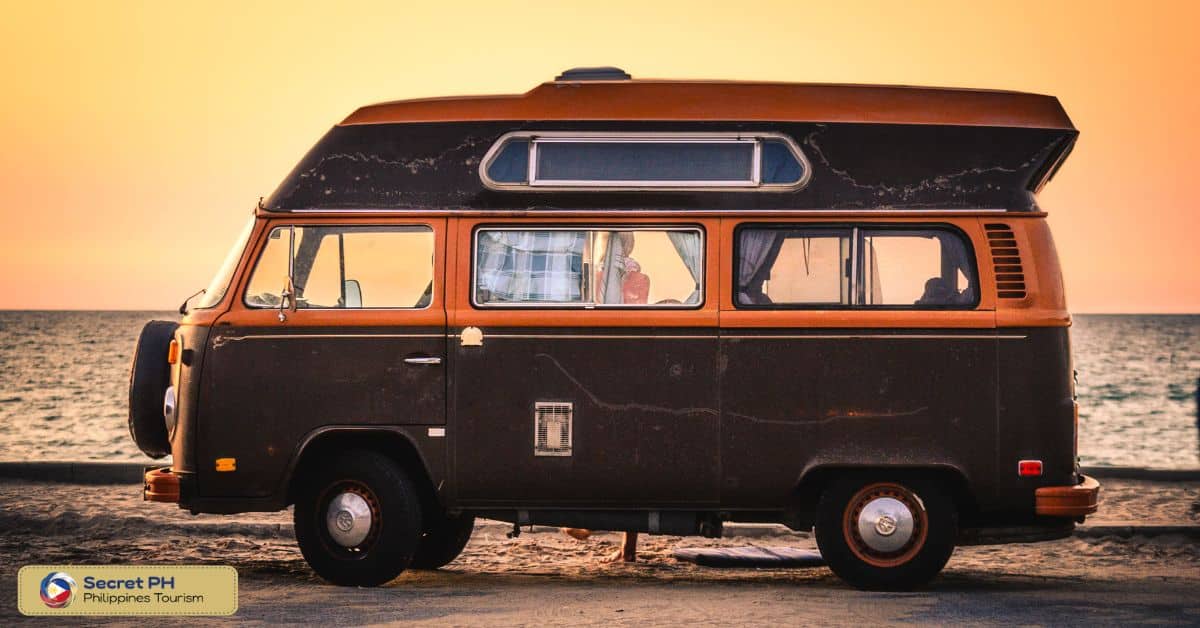
Habal-habal
The habal-habal is a type of motorcycle used as a mode of transportation in the countryside. It is often used in remote or rural areas where other forms of transportation are not available. The habal-habal is typically operated by a single rider. Passengers sit behind the driver on the back of the motorcycle. The fare is usually negotiated in advance, and habal-habal trips can be more affordable than other modes of transportation in the countryside.
| ADVANTAGES | DISADVANTAGES |
| Flexible | Uncomfortable |
| Good for Short Distances | Unsafe |
| Affordable | Limited Availability |

Tips for Exploring the Countryside
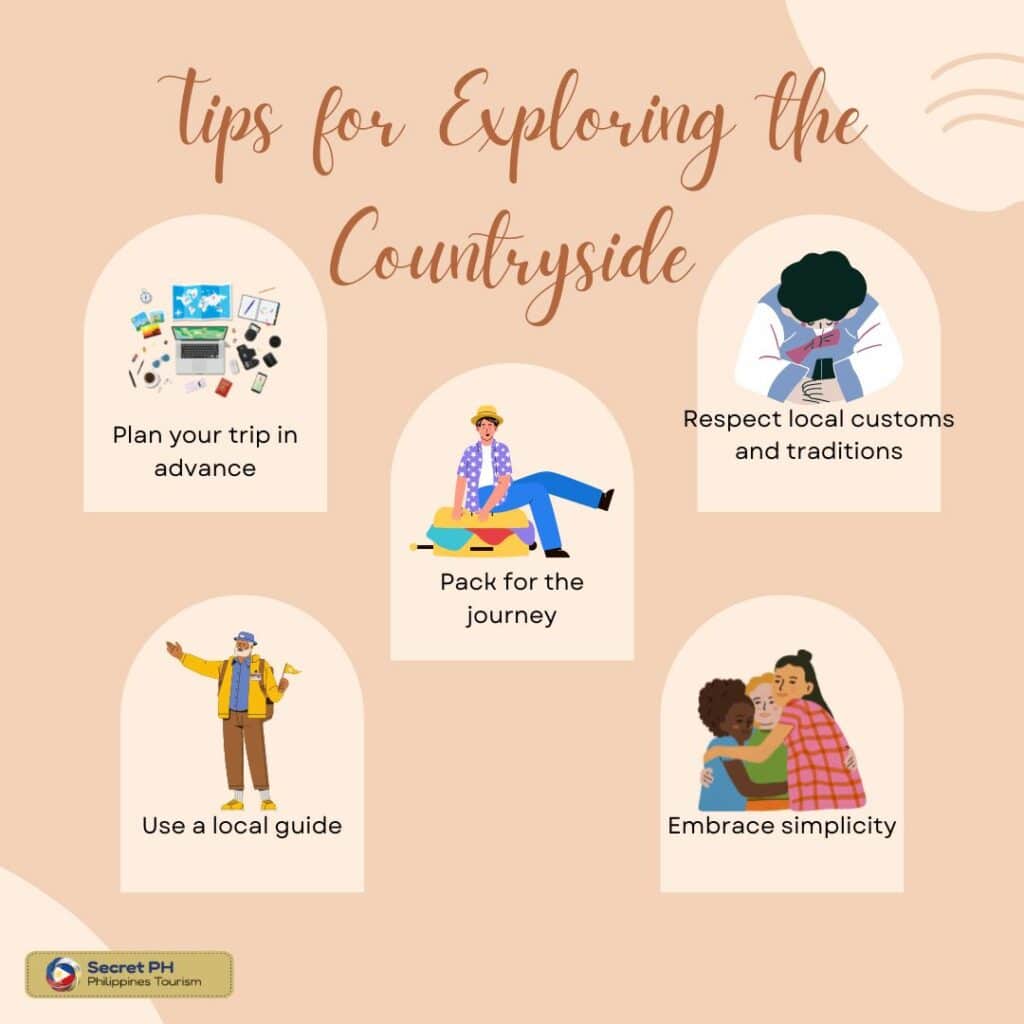
Plan your trip in advance
Research the best time to visit, the weather conditions, and the various activities and attractions available in the areas you plan to explore.
Respect local customs and traditions
Be mindful of the cultural norms and customs of the rural communities you visit, and take care to respect the local environment and wildlife.
Pack for the journey
Bring appropriate clothing and footwear for outdoor activities, as well as a hat, sunscreen, and insect repellent to protect against the sun and insects.
Use a local guide
Hiring a local guide can greatly enhance your experience, as they can provide valuable insights into the local culture, history, and ecology of the area.
Embrace simplicity
Leave your electronic devices at home and focus on enjoying the natural beauty of the countryside. Slow down, breathe deeply, and allow yourself to be fully present in the moment.
In Conclusion
The transportation infrastructure in the Philippines can vary greatly depending on whether you’re navigating through crowded cities or taking a journey into the countryside. In metro areas, finding your way from one point to another requires knowledge and skill as there are frequently traffic jams, long waits at bus stops, and often unpredictable travel plans.
However, for those that wish to discover the Philippines’ natural outdoors the countryside provides serene rides through mountain terrain and rugged coastlines. While transportation challenges remain for Philippines travelers, the solutions always depend on finding the right balance between negotiating urban chaos and getting away from it all into nature.

